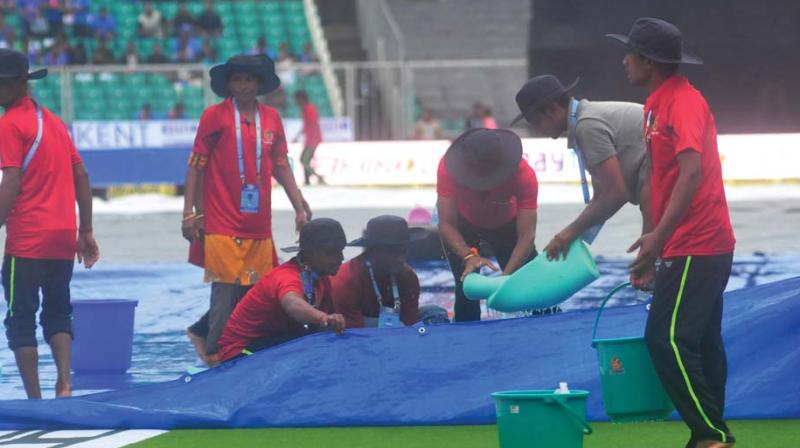Grounds-keeping team made T-20 possible
The ground staff comprising 50 workers including six Kudumbasree workers, had taken over the ground three days prior to the match.

THIRUVANANTHAPURAM: The grounds-keeping team at Sports Hub Kariavattom has been flooded with congratulatory messages from across the country and even abroad for the amazing work they carried out to set the stage for the short duration India New Zealand thriller on Tuesday.
The ground staff comprising 50 workers including six Kudumbasree workers, had taken over the ground three days prior to the match. Heavy spells of rain that occurred two - three days before the match helped the workers hone their skills of high-speed ground covering and removing water. Some of them have already been trained in dealing with sudden spells of showers.
The team worked tirelessly through the day on Tuesday which made the eight over a side match possible. It rained continuously almost for five hours. During this period the staff was moved into the ground at least three times.
“Our team has been managing the Sports Hub, St Xavier’s Ground Thumba and KCA stadium at Thonackal. Kudumbasree workers have been associated with these grounds for the past three years. They have basic training in ground management and cleaning activities,” said venue director, Vinod S Kumar.
According to him, the stadium has a fishbone drainage system. The rainwater on the lush green surface is soaked in by the sand base, water goes out through perforated pipes into the gutter/moat along the stadium.
The natural grass is over medium fine sand with organic matter. This is the reason outfields are ready for play 30 minutes after the rain stops completely. Basically the fishbone system does not allow accumulation of water on the outfield.
“As per ICC rules each venue should have two super soppers. We had also pressed into service two which worked continuously at last for three hours,” said Edwin, chairman Grounds Committee of KCA. A super sopper has a capacity of 150 litres. The sponge soaks up the water and the hydraulic pump throws out the water into the gutter.
“We used 30-odd staff with mops and buckets to remove water that accumulated on the covers. Once the water was drained out, super sopper was used to dry the covers. Our team worked like a well-oiled machine and cleaned the ground at least two to three times,” said Vinod.
Experts say sand-based outfields with underground drainage system have their own set of problems. There is always the danger of pores getting closed during super sopper operations. Moreover, there is accumulation of wetness in a larger area.
M.A. Chinnaswamy stadium in Bangalore has an advanced drainage system with sub air compatible base for cricket outfield along with perimeter drainage channel.
KCA sources said that at the time of the construction of the greenfield stadium, the highly advanced system was not introduced here. Moreover, it was also very expensive.
Unicover is another method being mooted to solve the problem of rains during games. The entire ground is covered with a single waterproof cover.

